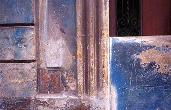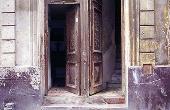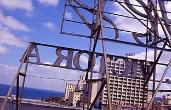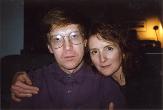| SOUNDTRACK SCREENPLAY DOWNLOADS SCREENINGS DVD |  |
|
|
 |
 |
 |
 |
 |
 |
|
||||||
|
HAVANA El Norte: An Ill Wind? Our Man In Havana Breakfast at the Hotel Nacional The Riviera At the British Embassy Soy Cuba Back to Diary Index |
Soy Cuba Later, before leaving, we walk to the Old Town and visit a pastry shop. Pink walls, dry pastries, young and lovely prostitutes befriending overweight western men conspicuously laden with cameras. The women are tremendously good actresses. They seem genuinely interested in and attracted by these horrible specimens, whose only possible asset is the money they carry in their wallets. I am reminded once again of the contradictions in this country that lead to it's becoming the place where the two lovers meet again at the end of the story. A land of disintegrating buildings, vibrant music, surrounded by a sparkling sea. A land where there is virtually no illiteracy, no homelessness, and whilst the diet may be monotonous, no hunger; a land where health care and dentistry are free, but where recently, people could not buy soap. A land where there was a revolution, not so long ago, and the idea of dream of equality for all is still present, despite some terrible abuses of gays and dissidents. (Though I talked with some gay filmmakers who said conditions have much improved recently.) But in a global situation where civil rights are daily increasingly eroded in the so-called democracies, and where religious fundamentalisms are clashing in deadly and ever more repressive ways, moral high-ground taken about rights abuses in Cuba seems hypocritical and the secular socialist dream looks appealing, at least to the visitor. It's a relief to walk down a main street in a city and not be bombarded with corporate logos, with billboards advertising things you don't need, creating ever and greater hunger for things, things, things. 'Soy Cuba' ('I am Cuba') was the film everyone was talking about at the Film Festival. A new print was being shown, and a documentary about its making. Directed by Kalatozov (of 'Cranes Are Flying') in 1964 and photographed by Urelevsky, it is a stunning lyric poem to a society in the process of change. Even the grating polemical propagandist voice-over (added later under pressure) cannot detract from the glories of the imagery. The extraordinary hand-held 35 mm camera work, the beauty of the landscapes, the faces, the feeling of a huge vision. Opposite the Nacionଠis the Hotel Capri where the opening sequence was filmed. It begins on the roof and, in one seamless take, follows the protagonist as he descends in an elevator, out onto another roof where there is a swimming pool, and then keeps following him as he makes his way through the sunbathing frolicking crowds, on and on, into the water and then - amazingly - under the water. Alexei Rodionov, ( who filmed 'Orlando' as well as YES) was Urelevsky's assistant on his last film and knows the secrets of how these sequences were filmed. I spent many happy hours during the preparations for YES drawing him out and marvelling at his descriptions of the hand-made inventiveness which puts most mega-budget and special-effects features to shame with its sheer raw virtuosity. The Capri is now abandoned. I stand in the wind on the rooftop of the Nacionଠpeering at its decaying facade, searching for the ghosts of 'Soy Cuba'. back |
 Havana’s disintegrating buildings….   ‘I Am Cuba’  Hotel Capri seen from rooftop  Cinematographer Alexei Rodionov with SP |
||||
Text © Sally Potter. All pictures © Adventure Pictures unless otherwise indicated |